-
 Bitcoin
Bitcoin $107,247.2038
-0.18% -
 Ethereum
Ethereum $2,424.7947
0.34% -
 Tether USDt
Tether USDt $1.0003
-0.02% -
 XRP
XRP $2.1171
-3.33% -
 BNB
BNB $645.6618
0.06% -
 Solana
Solana $141.5898
-1.32% -
 USDC
USDC $0.9998
0.00% -
 TRON
TRON $0.2710
-0.41% -
 Dogecoin
Dogecoin $0.1602
-2.99% -
 Cardano
Cardano $0.5553
-2.28% -
 Hyperliquid
Hyperliquid $36.3019
-2.42% -
 Bitcoin Cash
Bitcoin Cash $491.7212
2.04% -
 Chainlink
Chainlink $13.0810
-0.23% -
 Sui
Sui $2.6080
-5.06% -
 UNUS SED LEO
UNUS SED LEO $9.0040
-0.05% -
 Stellar
Stellar $0.2350
-3.06% -
 Avalanche
Avalanche $17.2294
-2.31% -
 Toncoin
Toncoin $2.8075
-1.05% -
 Shiba Inu
Shiba Inu $0.0...01121
-3.43% -
 Litecoin
Litecoin $84.2215
-0.32% -
 Hedera
Hedera $0.1429
-4.88% -
 Monero
Monero $312.2199
-0.90% -
 Dai
Dai $0.9997
-0.01% -
 Ethena USDe
Ethena USDe $0.9999
-0.02% -
 Polkadot
Polkadot $3.2973
-2.60% -
 Bitget Token
Bitget Token $4.4742
3.12% -
 Pi
Pi $0.5631
-10.10% -
 Uniswap
Uniswap $6.7817
-2.06% -
 Pepe
Pepe $0.0...09252
-3.74% -
 Aave
Aave $251.3830
-2.24%
Is it credible that the weekly level bottom diverges but the daily line is still falling?
Weekly bottom divergence suggests weakening bearish momentum, but a falling daily chart may still persist due to short-term pressure or market sentiment.
Jun 27, 2025 at 02:07 am
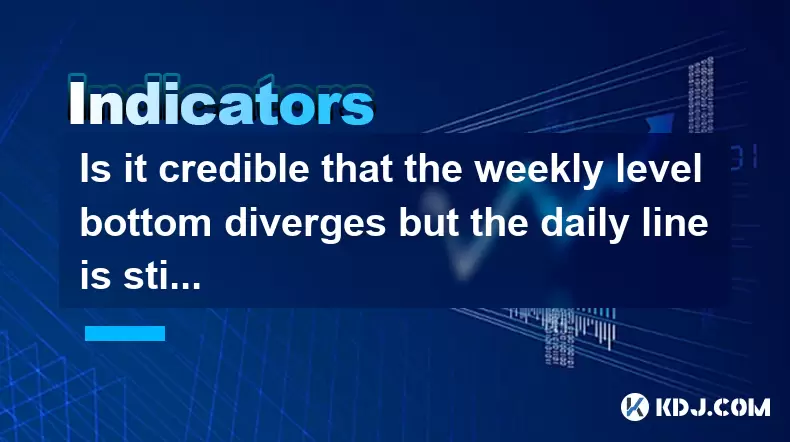
Understanding Divergence in Cryptocurrency Trading
In the cryptocurrency market, divergence refers to a situation where the price of an asset moves in one direction while a technical indicator moves in the opposite direction. This phenomenon is often used by traders to anticipate potential reversals. When discussing weekly level bottom divergence, it implies that on the weekly chart, the price has formed a lower low while the indicator (such as RSI or MACD) forms a higher low — suggesting weakening bearish momentum.
However, the question arises: what happens when this positive divergence appears on the weekly chart but the daily chart still shows a falling trend? This scenario can be confusing for traders who rely heavily on multi-timeframe analysis.
Divergence alone is not a guaranteed signal, especially when conflicting signals appear across different timeframes.
How Weekly Bottom Divergence Works
On the weekly timeframe, a bottom divergence typically indicates that despite the price hitting new lows, the underlying momentum is not confirming these lows. This may suggest that selling pressure is waning and buyers might soon step in.
To identify this, traders usually look at oscillators like RSI or MACD. For instance, if the price hits a new weekly low but the RSI does not reach a corresponding new low, that's a classic sign of bullish divergence.
- RSI Divergence: Price makes lower lows, but RSI makes higher lows.
- MACD Divergence: Price declines, but the MACD line starts to rise or form higher lows.
This could imply that the downtrend may reverse, especially if supported by volume or other indicators. However, this doesn't mean the reversal will happen immediately or even on the daily chart.
Why the Daily Chart Might Still Be Falling
Even with a weekly-level bullish divergence, the daily chart can continue to fall due to several factors:
- Short-term bearish dominance: Despite long-term signs of strength, short-term traders may continue pushing the price down.
- Lack of immediate buying pressure: The divergence may indicate future strength, but until actual buying comes in, the price may keep declining.
- Market sentiment and external news: Events such as regulatory announcements, exchange issues, or macroeconomic changes can override technical signals.
It’s important to understand that divergence suggests a potential change in trend, not an immediate reversal. In volatile markets like cryptocurrencies, timing is critical, and divergence should be used alongside other tools such as support/resistance levels, moving averages, and volume analysis.
Practical Steps to Analyze This Scenario
If you observe a weekly bottom divergence while the daily chart continues to decline, follow these steps to assess the situation more accurately:
- Confirm the divergence on multiple indicators: Use both RSI and MACD to verify if they’re showing similar divergent behavior.
- Analyze key support zones on the daily chart: Even if the price is falling, check whether it’s approaching a major support area that could trigger a bounce.
- Monitor volume patterns: Rising volume during divergence periods may strengthen the case for a reversal.
- Check for confluence with Fibonacci retracement levels: If the divergence aligns with a key retracement level, it adds credibility to the potential reversal.
- Use candlestick patterns for confirmation: Bullish candlestick formations like hammer, engulfing, or morning star near key support levels can act as triggers.
These steps help filter out false signals and increase the probability of identifying a genuine reversal point.
Real Market Examples and Observations
Take Bitcoin as an example. Suppose it dropped from $30,000 to $25,000 over several weeks, forming a lower low on the weekly chart. Meanwhile, the weekly RSI made a higher low, indicating a possible bottom formation.
However, on the daily chart, the price continued to fall toward $24,000, with no clear reversal pattern visible. Traders observing this would need to ask: is the weekly divergence strong enough to justify a trade?
In real-world scenarios, many experienced traders wait for confirmation on the daily chart before acting. Some may place limit orders near strong support levels or use options strategies to hedge their exposure without fully committing capital.
Frequently Asked Questions
Q1: Can divergence on the weekly chart be ignored if the daily chart is bearish?
A: No, it shouldn’t be ignored, but it also shouldn’t be acted upon blindly. Treat it as a warning sign rather than a direct buy/sell signal. Combine it with daily chart confirmation before making decisions.
Q2: How reliable is RSI divergence compared to MACD divergence?
A: Both have strengths. RSI is better for identifying overbought/oversold conditions, while MACD excels at capturing momentum shifts. It's best to use them together for stronger confirmation.
Q3: What timeframes should I use to confirm weekly divergence?
A: Typically, the daily and 4-hour charts are used to find entry points after spotting divergence on the weekly chart. These provide a balance between trend context and actionable signals.
Q4: Does divergence always lead to a reversal?
A: No, divergence can occur during strong trends and may not result in a reversal. It only indicates weakening momentum. Always look for additional confirmation through price action or volume.
Disclaimer:info@kdj.com
The information provided is not trading advice. kdj.com does not assume any responsibility for any investments made based on the information provided in this article. Cryptocurrencies are highly volatile and it is highly recommended that you invest with caution after thorough research!
If you believe that the content used on this website infringes your copyright, please contact us immediately (info@kdj.com) and we will delete it promptly.
- Ruvi AI vs. Tron: The Race to the $1 Mark and Beyond
- 2025-06-27 06:50:12
- Bitcoin, Ethereum, and Inflation Data: Navigating the Crypto Landscape
- 2025-06-27 06:55:12
- UAE, Crypto, and Trump: A Surprising Intersection in 2025
- 2025-06-27 06:55:12
- BTC Bull Token: Price Prediction and the 50x Potential
- 2025-06-27 06:57:14
- Moonveil's $MORE Token Launching on CEXs: A New Era for Web3 Gaming
- 2025-06-27 06:31:58
- Crypto Presales in 2025: MAGACOIN FINANCE and the Hunt for New Coins
- 2025-06-27 04:50:12
Related knowledge
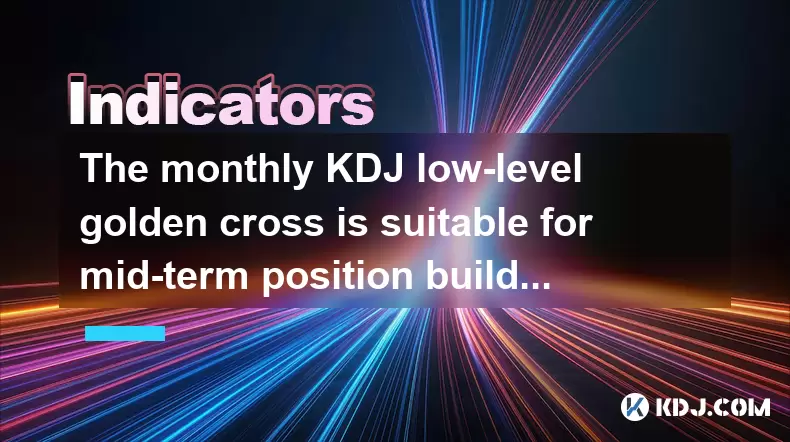
The monthly KDJ low-level golden cross is suitable for mid-term position building?
Jun 27,2025 at 03:14am
Understanding the Monthly KDJ IndicatorThe KDJ indicator, also known as the stochastic oscillator, is a momentum tool widely used in technical analysis within the cryptocurrency market. It consists of three lines: the K line, the D line, and the J line. These lines help traders identify overbought or oversold conditions, potential trend reversals, and e...
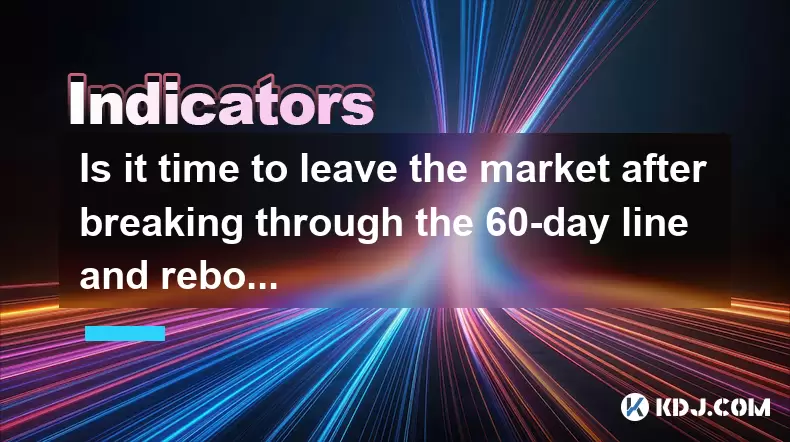
Is it time to leave the market after breaking through the 60-day line and rebounding?
Jun 27,2025 at 06:29am
Understanding the 60-Day Moving Average in CryptocurrencyIn cryptocurrency trading, technical indicators play a pivotal role in decision-making. Among these, the 60-day moving average is widely used by both novice and experienced traders. This indicator calculates the average price of an asset over the last 60 days and helps identify long-term trends. W...
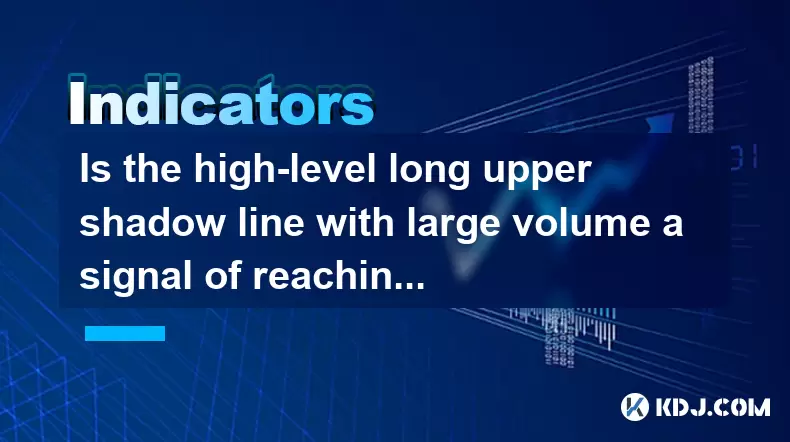
Is the high-level long upper shadow line with large volume a signal of reaching the top?
Jun 27,2025 at 04:50am
Understanding the High-Level Long Upper Shadow LineIn technical analysis within the cryptocurrency market, candlestick patterns play a crucial role in predicting price movements. A high-level long upper shadow line, often referred to as a shooting star or inverted hammer, is a specific type of candlestick pattern that appears at the top of an uptrend. T...
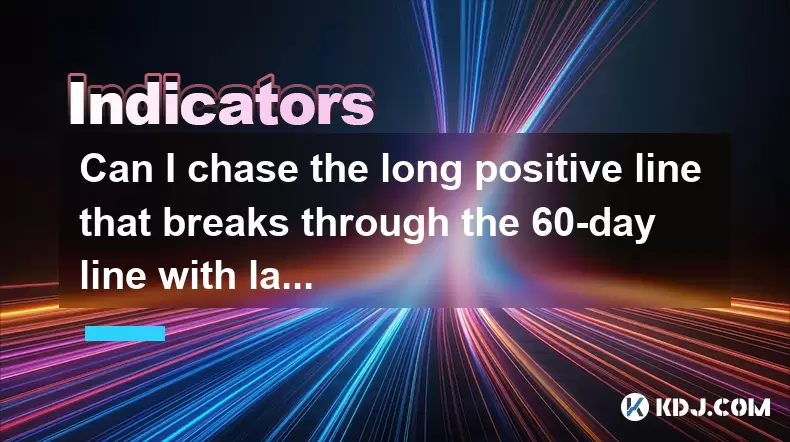
Can I chase the long positive line that breaks through the 60-day line with large volume at the bottom?
Jun 27,2025 at 07:08am
Understanding the 60-Day Line in Cryptocurrency TradingIn cryptocurrency trading, technical analysis plays a pivotal role in identifying potential entry and exit points. One of the commonly used tools is the 60-day moving average, often referred to as the 60-day line. This indicator smooths out price data over the last 60 days and helps traders determin...
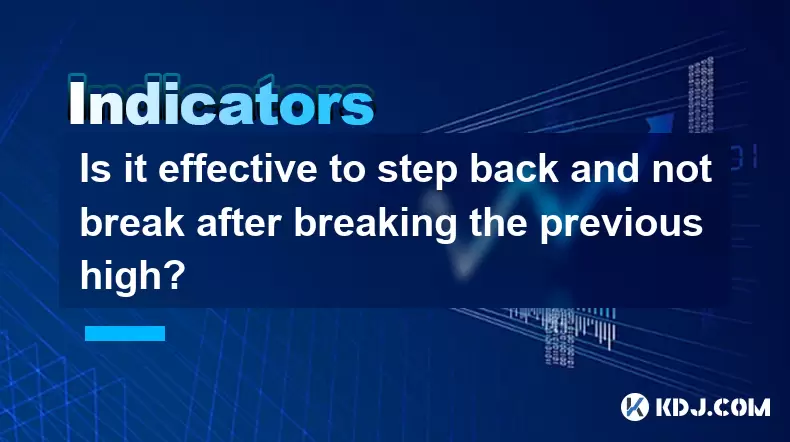
Is it effective to step back and not break after breaking the previous high?
Jun 27,2025 at 05:01am
Understanding the Concept of Breaking Previous HighsIn cryptocurrency trading, breaking a previous high refers to when an asset's price surpasses its last recorded peak. This is often seen as a sign of strong momentum and bullish sentiment. Traders closely monitor these levels because they can indicate potential trend continuation or reversal points. Wh...
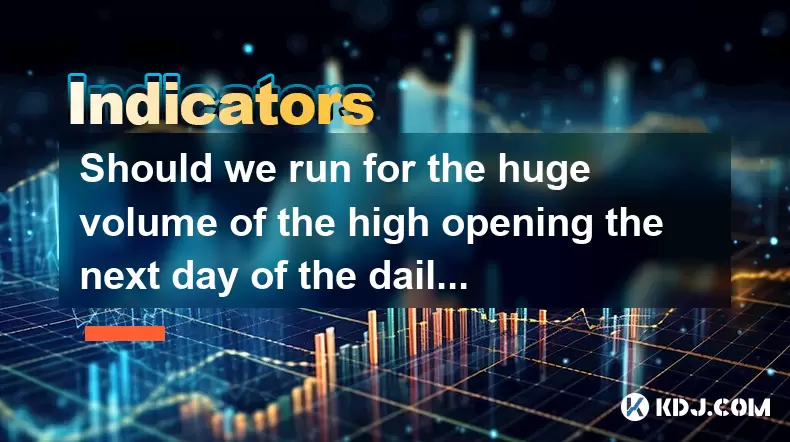
Should we run for the huge volume of the high opening the next day of the daily limit?
Jun 27,2025 at 06:07am
Understanding Daily Limits in Cryptocurrency TradingIn the world of cryptocurrency trading, daily limits refer to price restrictions imposed by exchanges or self-imposed by traders to manage volatility and risk. A daily limit up occurs when the price of a digital asset rises to the maximum allowable percentage within a single trading day. This phenomeno...

The monthly KDJ low-level golden cross is suitable for mid-term position building?
Jun 27,2025 at 03:14am
Understanding the Monthly KDJ IndicatorThe KDJ indicator, also known as the stochastic oscillator, is a momentum tool widely used in technical analysis within the cryptocurrency market. It consists of three lines: the K line, the D line, and the J line. These lines help traders identify overbought or oversold conditions, potential trend reversals, and e...

Is it time to leave the market after breaking through the 60-day line and rebounding?
Jun 27,2025 at 06:29am
Understanding the 60-Day Moving Average in CryptocurrencyIn cryptocurrency trading, technical indicators play a pivotal role in decision-making. Among these, the 60-day moving average is widely used by both novice and experienced traders. This indicator calculates the average price of an asset over the last 60 days and helps identify long-term trends. W...

Is the high-level long upper shadow line with large volume a signal of reaching the top?
Jun 27,2025 at 04:50am
Understanding the High-Level Long Upper Shadow LineIn technical analysis within the cryptocurrency market, candlestick patterns play a crucial role in predicting price movements. A high-level long upper shadow line, often referred to as a shooting star or inverted hammer, is a specific type of candlestick pattern that appears at the top of an uptrend. T...

Can I chase the long positive line that breaks through the 60-day line with large volume at the bottom?
Jun 27,2025 at 07:08am
Understanding the 60-Day Line in Cryptocurrency TradingIn cryptocurrency trading, technical analysis plays a pivotal role in identifying potential entry and exit points. One of the commonly used tools is the 60-day moving average, often referred to as the 60-day line. This indicator smooths out price data over the last 60 days and helps traders determin...

Is it effective to step back and not break after breaking the previous high?
Jun 27,2025 at 05:01am
Understanding the Concept of Breaking Previous HighsIn cryptocurrency trading, breaking a previous high refers to when an asset's price surpasses its last recorded peak. This is often seen as a sign of strong momentum and bullish sentiment. Traders closely monitor these levels because they can indicate potential trend continuation or reversal points. Wh...

Should we run for the huge volume of the high opening the next day of the daily limit?
Jun 27,2025 at 06:07am
Understanding Daily Limits in Cryptocurrency TradingIn the world of cryptocurrency trading, daily limits refer to price restrictions imposed by exchanges or self-imposed by traders to manage volatility and risk. A daily limit up occurs when the price of a digital asset rises to the maximum allowable percentage within a single trading day. This phenomeno...
See all articles
























































































